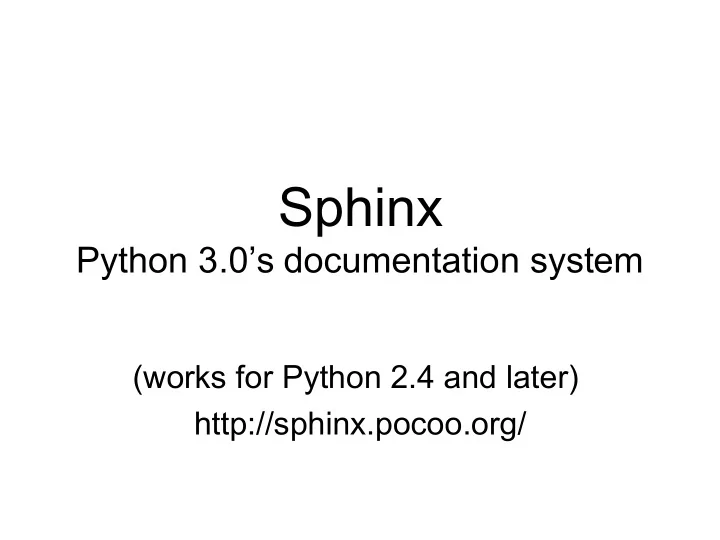

Sphinx Python 3.0’s documentation system (works for Python 2.4 and later) http://sphinx.pocoo.org/
Sphinx output • Customisable HTML and LaTeX • HTML in multiple files with: – Extensive cross-references – Hierarchical structure • Indices and search facility • Code highlighting with Pygments (Python 3.0 example on next slide)
Sphinx input • Text files in reStructuredText format • Extensions to reStructuredText for “semantic markup” • Documentation can be in separate files, or can be automatically pulled from docstrings in your code
reStructuredText • Half way between something like HTML and plain text, e.g.: Title Title ===== Blah, *blah*, **blah**. Blah, blah , blah . Section Section ------- * Bullet •Bullet * List •List
Sphinx semantic markup .. class:: Shark(numberofteeth=Many) Creates a shark, has the following methods: .. method:: bite(victim=‘passerby’) Tells the shark who to bite, after a biting :attr:`number_of_victims` increases by 1. and attributes: .. attribute:: number_of_victims What it sounds like… Avoid using the :meth:`Shark.bite` method.
Using docstrings • Just use the following Sphinx markup: .. autoclass:: Shark .. autofunction:: rescue_mission Etc.
Index • Classes, functions, etc. automatically generate index entries. • In addition, you can add your own index entries as follows: .. index: pair: shark; attack single: Jaws
And in conclusion… • Sphinx seems a good choice of documentation system as it is: – Easy to use and powerful – Generates very nice output – Likely to be well supported as it is being used for Python 3.0 docs • See it in action: http://docs.python.org/dev/3.0/ • Download it: http://sphinx.pocoo.org/index.html
Recommend
More recommend